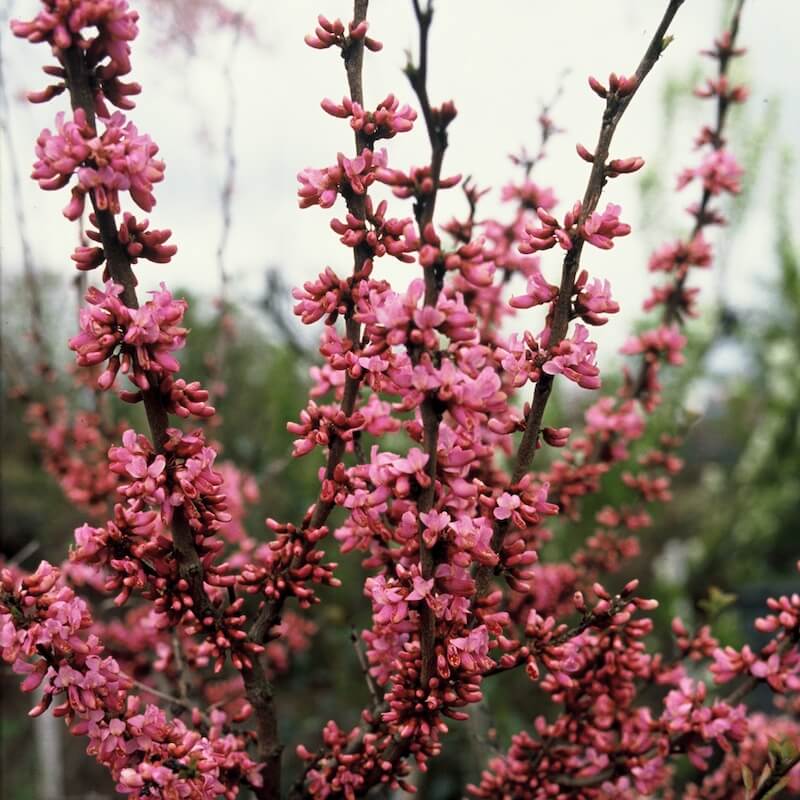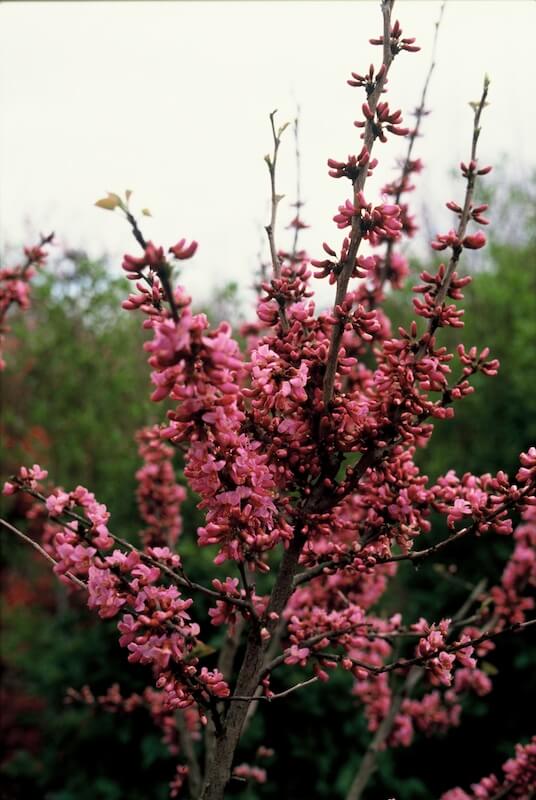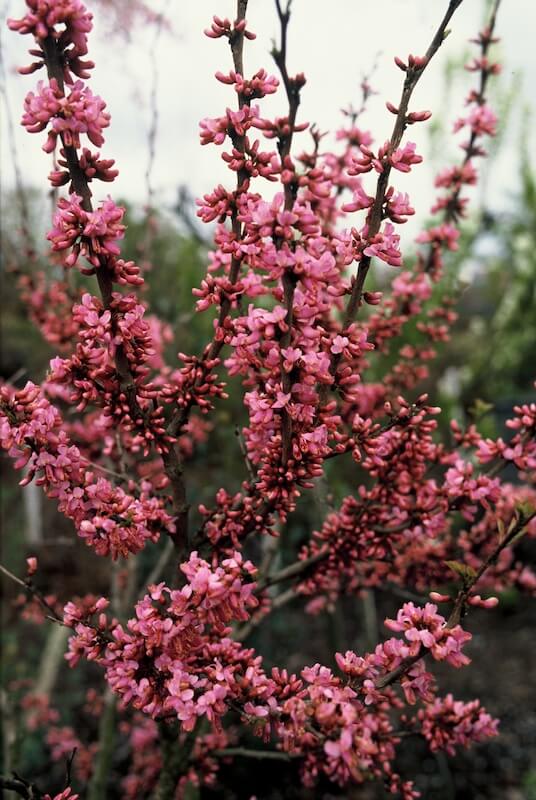Cercis chinensis Avondale – Spring Blossom, Summer Foliage, Autumn Colour
Chinese redbud Avondale

Position
- Prefers full sun to light shade; a warm, sheltered spot (e.g. against a south- or west-facing wall) encourages prolific flowering
- Tolerates light shade but flowers most abundantly in sun
- Avoids sites with strong, drying winds to protect early buds
Hardiness
- Tolerates winter temperatures down to around –15 °C (5 °F)
- Performs reliably across the UK; a light mulch benefits young trees in exposed locations
Soil
- Thrives in deep, well-drained, fertile soil
- Benefits from soil improvement at planting with plenty of compost or well-rotted manure
- Avoids heavy clay that remains waterlogged or very free-draining sandy soils without improvement
- Adaptable to acid, neutral or alkaline conditions
- Performs best where organic matter maintains good structure and moisture balance
- Grab a soil test kit and ensure the perfect conditions for growth
Height
- Typically reaches 3–4 m (10–13 ft) tall after 5–10 years
- Spreads to a similar width, forming a rounded, vase-shaped canopy
Seasons of Interest
- Flowering: Masses of rich pink pea-like blossoms appear on bare wood in April–May, creating a dramatic spring display
- Foliage: Young leaves emerge bronze-pink, maturing to fresh green through summer for ongoing interest
- Autumn Colour: Leaves turn bright yellow in October before falling, adding late-season appeal
Additional Notes
- Lightly prune immediately after flowering to shape and remove any dead wood
- Mulch in spring with garden compost to conserve moisture and support healthy new growth
- Ensure good autumn drainage—avoid waterlogging beneath the canopy
- Highly attractive to bees and early pollinators when in flower
- Excellent as a small ornamental tree or trained as an espalier in confined spaces
Cercis chinensis Avondale – The Ornamental Tree That Transforms Your Garden Year-Round
If you’re looking for an ornamental tree that offers a spectacular display from spring through autumn, Cercis chinensis Avondale might just win your heart. Known as the Chinese redbud, this shrub or small tree delivers vibrant purple-pink flowers in dense clusters along bare stems in early spring, followed by rich green foliage that turns yellow in autumn. It’s a plant that’s as easy to grow as it is rewarding, making it a standout choice for gardeners who love seasonal colour and structure.
What is Cercis chinensis and Why is it Special?
Cercis chinensis, or Chinese redbud, is a deciduous shrub known for its distinctive clusters of deep purple-pink flowers that burst into bloom from March to April. These pea-like flowers appear directly on bare stems, a rare trait that ensures an unforgettable spring display. In the case of the popular Avondale variety, the dense clusters of deep pink blooms are especially striking.
This plant is prized in ornamental gardens for its unique flowering habit and heart-shaped leaves that emerge after the blossom display. The foliage is a rich green in summer, turning buttery shades of yellow in autumn before it is shed. Its manageable size and bushy habit mean it works well in small gardens or as a feature in larger spaces.
How Does the Avondale Variety Stand Out Among Redbud Trees?
The Avondale cultivar of Cercis chinensis is particularly sought after for its upright shoots, glossy leaves, and compact form. Unlike larger redbud trees, this variety stays manageable at an ultimate height of around 4m, making it suitable for smaller plots or courtyard gardens.
What makes ‘Avondale’ extra special is its intense dark purple-pink flowers that smother the branches in early spring. These blooms are often described as producing a spectacular display, especially when contrasted against bare stems. The glossy leaves emerge soon after, adding seasonal interest right through to the yellow in autumn colour change.

Where is the Best Place to Plant a Chinese Redbud?
Chinese redbud thrives in a sunny or lightly shaded position. For the best flower display, aim for full sun, but it will tolerate partial shade. The ideal spot offers some shelter from strong winds, as these can damage the flower buds before they open.
Choose well-drained soil that’s also fertile, and improve it before planting by adding well-rotted compost. If planting near taller trees, dappled shade is fine, though flowering may be slightly reduced. This deciduous shrub looks particularly striking when planted where its bare stems can be seen up close in spring.
What Soil Conditions Does a Chinese Redbud Need?
Cercis chinensis prefers fertile, well-drained soil. Avoid locations where water tends to sit after heavy rain, as overly wet roots can harm the plant. If your garden soil is heavy clay, improve drainage by incorporating grit and organic matter.
A layer of compost around the base in spring will feed the plant and conserve soil moisture during summer. As a relatively easy-to-grow ornamental tree, it’s adaptable, but optimal flowering comes from healthy root conditions.
When and How Does Cercis chinensis Flower?
From April to May, Avondale produces dense clusters of deep pink pea-like flowers directly along bare stems. This unusual trait is called cauliflory and creates a spectacular spring display before any foliage appears.
The flowers are small but profuse, forming in tight clusters that cover the plant. These blooms are not only visually striking but also signal the start of the garden’s spring season in a most dramatic way.
Comparing the Judas Tree with Other Ornamental Trees
Compared with many ornamental trees, Cercis siliquastrum offers exceptional multi-season interest. Unlike some shrubs or small trees that rely solely on their flowers, the Judas tree delivers colour in spring, distinctive foliage in summer, striking autumn tones, and ornamental pods for winter.
Its compact habit makes it versatile for urban gardens, cottage gardens, and more formal settings. Unlike larger deciduous trees, it won’t overpower smaller plots, yet still delivers a strong architectural presence.
What Does the Foliage Look Like?
Once the flowers fade, heart-shaped leaves emerge in a fresh, rich green colour. These glossy leaves remain attractive through summer, giving the shrub a lush appearance.
In autumn, the foliage turns yellow, sometimes with hints of buttery gold. The leaves are shed in autumn, leaving the upright shoots bare once again and ready for another spring display.
How Tall Will an Avondale Redbud Grow?
Cercis chinensis Avondale typically reaches an ultimate height of around 4m with a spread of about 2.5m. This makes it an excellent choice for gardens that cannot accommodate larger ornamental trees.
Growth is generally moderate, and its compact, bushy form means it won’t overpower smaller planting schemes. With minimal pruning, it will maintain an attractive shape naturally.
How to Care for Your Chinese Redbud Throughout the Year
Water regularly in the first two years after planting, especially in dry spells. Once established, Avondale is relatively drought-tolerant, though prolonged dryness can reduce flowering.
Mulch in spring with compost to nourish the roots and keep weeds down. Light pruning after flowering can remove any crossing or damaged branches, but avoid heavy cutting as this may reduce next year’s blooms.
Why is Avondale a Great Choice for UK Gardens?
Avondale is an easy-to-grow, low-maintenance option that delivers maximum seasonal interest. It thrives in UK conditions, tolerating winter cold and summer warmth, provided the soil is well-drained.
Its compact size, beautiful flowers, and attractive foliage make it a versatile choice for ornamental borders, focal points, or even large containers. Recognised with the RHS Award of Garden Merit, it’s a plant with proven garden value.
From Darren’s Patch
Although I’m not growing Avondale in my garden at the moment, I often recommend it to fellow gardeners because it gives such dramatic early-season colour with very little fuss. Those dense clusters of purple-pink flowers on bare stems are unforgettable, and the glossy, heart-shaped leaves that follow give summer structure before turning buttery yellow in autumn. It’s compact, easy to grow in well-drained, fertile soil enriched with compost, and benefits from a light feed in spring and a gentle tidy after flowering. I’d place it where the bare stems can be admired close-up — a patio, border focal point or courtyard — so its spring spectacle isn’t missed. For anyone wanting seasonal drama without heavy maintenance, Avondale is a dependable, elegant choice.
![]()
Key Points to Remember
- Flowers: Dense clusters of deep pink blooms from March to April on bare stems
- Foliage: Heart-shaped leaves, rich green in summer, turning buttery yellow in autumn
- Height: Ultimate height around 4m, spread 2.5m
- Position: Best in full sun but tolerates partial shade and dappled shade
- Soil: Fertile, well-drained soil enriched with well-rotted compost
- Care: Water in dry spells, mulch in spring, stake during establishment
- Value: Easy to grow, compact, and stunning in every season
Cercis chinensis Avondale flourishes in full sun to light shade on well-drained, improved soils of any pH and withstands down to –15 °C (5 °F). Within 5–10 years, it reaches 3–4 m (10–13 ft), offering a stunning display of pink spring flowers, bronze-tinted summer foliage and golden autumn colour. Simple spring mulch, light pruning and good drainage ensure reliable performance in UK gardens.
Want to learn about other ornamental tree varieties? Read about Cercis siliquastrum here.
For more information on Ornamental Trees for your garden, please click here.

Frequently Asked Questions
Q: What is Cercis chinensis Avondale?
A: Cercis chinensis Avondale, often called the Chinese redbud, is a compact deciduous shrub or small tree prized for its early spring display of dense clusters of deep pink, pea-like flowers. Blooming on bare stems from March to April, it creates a spectacular display before its rich green, glossy leaves emerge. These heart-shaped leaves turn buttery yellow in autumn, adding seasonal interest. Growing to around 2.5m–4m in height, Avondale is ideal for small gardens or as an ornamental focal point. It holds the RHS Award of Garden Merit for its beauty and reliability, making it a favourite among gardeners.
Q: How do I plant and care for a Chinese redbud?
A: To plant a Chinese redbud such as Cercis chinensis Avondale, choose a position in full sun or partial shade with well-drained, fertile soil. Dig a planting hole twice as wide as the root ball and enrich it with well-rotted compost. Place the tree so the top of the root ball is level with the surrounding soil, then backfill and firm gently. Stake during establishment to support upright shoots. Water well in the first year and feed in spring. Minimal pruning is needed — simply remove damaged or crossing branches after flowering. This ornamental shrub is easy to grow and maintain.
Q: When does Cercis chinensis Avondale flower?
A: Cercis chinensis Avondale produces its flowers in spring, typically from April to May, when its bare stems are adorned with dense clusters of deep pink, pea-like flowers. These blossoms appear before the foliage, creating a striking contrast and an exceptional early-season display. After flowering, glossy leaves emerge in a fresh, rich green, bringing a lush look to the garden. By autumn, the foliage turns buttery yellow before it is shed. This sequence of seasonal interest, from purple-pink blooms to autumn colour, ensures the shrub or small tree enhances the garden throughout much of the year.
Q: Where can I buy Cercis chinensis Avondale?
A: You can buy Cercis chinensis Avondale from reputable nurseries, garden centres, and online plant retailers in the UK. Many suppliers offer bare-root or potted specimens, with some providing detailed planting instructions. When buying, choose healthy plants with strong, well-formed stems and avoid any with damaged bark or signs of disease. Specialist ornamental tree nurseries may offer larger or more mature specimens for instant impact. Ordering online provides access to a broader range of sizes and delivery options, while visiting a nursery allows you to inspect the shrub in person before purchase.
